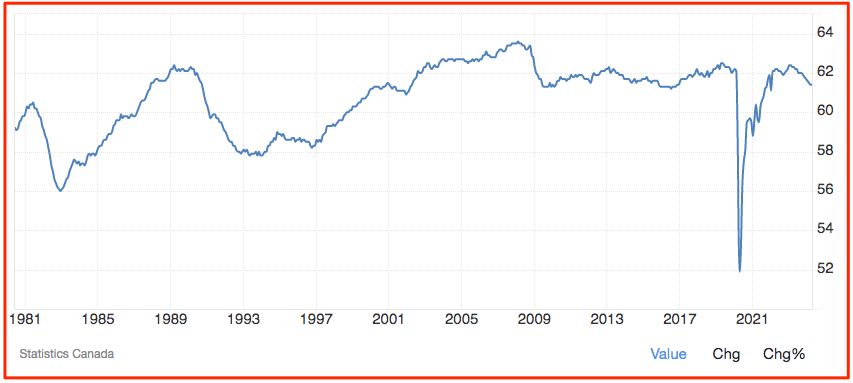

I know most of you will scroll below, see the charts I’ve added, and then bail on this email.
All good! Let me get this out quickly then …
Real Estate is about debt service (being able to pay). As long as people can pay their Mortgage, the market can side-step a lot of trouble.
If people can’t pay their bills, cracks in the market appear, and then spread wide open.
Calgary’s Real Estate market was a prime example of this phenomenon.
Oil popped November 2014. Over the next 24+ months there were mass lay offs, small business closures and negative economic contagion. It was grim. And Real Estate values dropped.
In fact, I spoke with a condo owner last week who purchased her condo back in 2014. Her value today is just getting back to what she originally paid.
During this period of general economic contraction, Calgary’s Real Estate market had low interest rates.
We were still in the backwash of the Great Financial Crisis, with the U.S. Federal Reserve rolling out Quantitative Easing.
Despite low interest rates, Calgary Real Estate values still dropped because of employment—or the outlook of employment.
This is why I’m adding charts below on employment and unemployment. It’s a piece of the puzzle worth having some basic context of.
Still with me? Chart time :-) …
Canadian Employment Rate:
The employment rate is the percentage of the labour force that is employed.
If we are to zoom in, the employment rate is at the same level as about 2008-2009 (great financial crisis), and when oil popped back in 2014-2015.
No doubt this is one result of higher interest rates, amongst many other factors.


Canadian Un-Employment Rate:
This is defined as people out of work, who are actively looking for employment.
We can see this percentage climbing back to pre-covid levels. With such a far look back in time, we are at very low unemployment numbers.
Canadian Average Weekly Earnings:
We can see Canadian average weekly earnings are at, or just above, 4% change year over year. This is above the inflation target of 1-3%.
Why This Is Important:
Several reasons:
- Inflation. The Bank of Canada’s mandate is to target inflation at 2%, with a somewhat acceptable rate of 1-3%. Inflation is the percentage of price change year over year. Supply of goods, and people’s ability to pay for said goods (demand) influence price change.
It’s possible with rising unemployment, that could lead to lower wage growth. This would cool spending (demand side of inflation). - Interest rates. The bond market is somewhat of a barometer for Canada’s economic outlook, and pricing in central bank rate cuts. If bond traders are sniffing out weakness in the economy, rates should drift lower.
For Alberta/Calgary’s economic cycle, which is seemingly the opposite to other parts of Canada, this would be good news for those of you renewing in 12-18 months.
(Please note I am advising you to plan for higher rates at renewal than you currently have. The Bank of Canada governor is telling Canadians we might not get back to pre-covid interest rates). - National Real Estate. I know, I know—Real Estate markets are hyper local. I get it. However, with a reasonably meaningful contingent of inter-provincial migration to Alberta/Calgary, Real Estate prices in other parts of Canada are noteworthy to watch.
Conclusion:
Who scrolled straight to here? Be honest ;-).
As long as homeowners can pay their Mortgage, a lot of damage to the Real Estate market—and Canadian economy—can be avoided.
In the face of artificially low interest rates, spawned from central bank Quantitative Easing programs from the fall out of the GFC, Calgary’s Real Estate market went down when oil went bust.
This is one recent example of how employment, not just low interest rates, influence Real Estate pricing.
Heck, look at Calgary’s market now!! In the face of higher interest rates, employment and incomes are feeling secure—and look at our market!! It’s rising.
I thought some visibility on National data would be helpful to note. Thanks for sticking with me in this email.
Talk soon,
Chad Moore
Recent Posts
Calgary Market Update—March 2025 Data
Here are some Calgary Real Estate numbers, across all property types, out of the gate for…
Interest Rates Up Or Down?
Hey Guys! Tariffs are here. Now what? Tiff Macklem, governor of the Bank of Canada, gave…
Bank of Canada Hot Mic Moment
Hey Guys! The Bank of Canada publishes "meeting deliberation notes" relating to the discussion of raising,…
Banker’s Damaging Admission
When the governor of the Bank of Canada speaks, we listen! Tiff Macklem, governor at…
January 2025 Market Stats
Let's look back at January 2025 Calgary Real Estate Board (CREB) data to make sense…
Mortgage Interest Rate Review
Hey Guys! Here's an example of how the Bank of Canada is in a balance…


